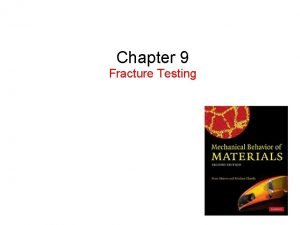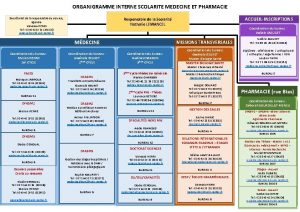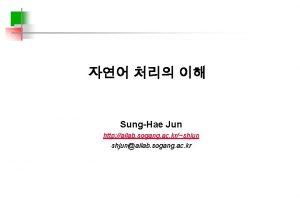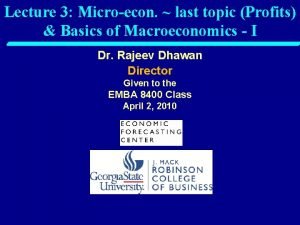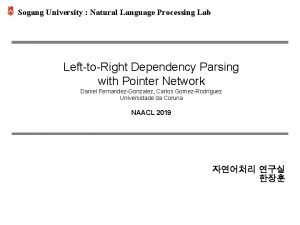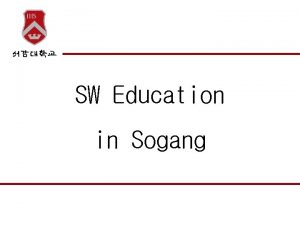Sogang Univ Microecon Seminar Impact of the Expansion
![[Sogang Univ. Microecon. Seminar] Impact of the Expansion of Private Brands on Korean Retail [Sogang Univ. Microecon. Seminar] Impact of the Expansion of Private Brands on Korean Retail](https://slidetodoc.com/presentation_image_h2/a0635d62dbde43141a5308733507aa68/image-1.jpg)
![[Motivation] [Trend] [Growth Background] [Impact-Retail] [Impact-Manufacture] [Contract] [Suggestion] Ⅰ. Motivations ■ Private Brand (PB) [Motivation] [Trend] [Growth Background] [Impact-Retail] [Impact-Manufacture] [Contract] [Suggestion] Ⅰ. Motivations ■ Private Brand (PB)](https://slidetodoc.com/presentation_image_h2/a0635d62dbde43141a5308733507aa68/image-2.jpg)
![[Motivation] [Trend] [Growth Background] [Impact-Retail] [Impact-Manufacture] [Contract] [Suggestion] ■ This study closely examines the [Motivation] [Trend] [Growth Background] [Impact-Retail] [Impact-Manufacture] [Contract] [Suggestion] ■ This study closely examines the](https://slidetodoc.com/presentation_image_h2/a0635d62dbde43141a5308733507aa68/image-3.jpg)
![[Motivation] [Trend] [Growth Background] [Impact-Retail] [Impact-Manufacture] [Contract] [Suggestion] Ⅱ. Current Status of the Domestic [Motivation] [Trend] [Growth Background] [Impact-Retail] [Impact-Manufacture] [Contract] [Suggestion] Ⅱ. Current Status of the Domestic](https://slidetodoc.com/presentation_image_h2/a0635d62dbde43141a5308733507aa68/image-4.jpg)
![[Motivation] [Trend] [Growth Background] [Impact-Retail] [Impact-Manufacture] [Contract] [Suggestion] ■ Recent Trends l The axis [Motivation] [Trend] [Growth Background] [Impact-Retail] [Impact-Manufacture] [Contract] [Suggestion] ■ Recent Trends l The axis](https://slidetodoc.com/presentation_image_h2/a0635d62dbde43141a5308733507aa68/image-5.jpg)
![[Motivation] [Trend] [Growth Background] [Impact-Retail] [Impact-Manufacture] [Contract] [Suggestion] ■ Korean retail chains’ share of [Motivation] [Trend] [Growth Background] [Impact-Retail] [Impact-Manufacture] [Contract] [Suggestion] ■ Korean retail chains’ share of](https://slidetodoc.com/presentation_image_h2/a0635d62dbde43141a5308733507aa68/image-6.jpg)
![[Motivation] [Trend] [Growth Background] [Impact-Retail] [Impact-Manufacture] [Contract] [Suggestion] ■ It has a strong potential [Motivation] [Trend] [Growth Background] [Impact-Retail] [Impact-Manufacture] [Contract] [Suggestion] ■ It has a strong potential](https://slidetodoc.com/presentation_image_h2/a0635d62dbde43141a5308733507aa68/image-7.jpg)
![[Motivation] [Trend] [Growth Background] [Impact-Retail] [Impact-Manufacture] [Contract] [Suggestion] Ⅲ. Growth Background: (1) Market Concentration [Motivation] [Trend] [Growth Background] [Impact-Retail] [Impact-Manufacture] [Contract] [Suggestion] Ⅲ. Growth Background: (1) Market Concentration](https://slidetodoc.com/presentation_image_h2/a0635d62dbde43141a5308733507aa68/image-8.jpg)
![[Motivation] [Trend] [Growth Background] [Impact-Retail] [Impact-Manufacture] [Contract] [Suggestion] ■ The share of corporate retailers’ [Motivation] [Trend] [Growth Background] [Impact-Retail] [Impact-Manufacture] [Contract] [Suggestion] ■ The share of corporate retailers’](https://slidetodoc.com/presentation_image_h2/a0635d62dbde43141a5308733507aa68/image-9.jpg)
![[Motivation] [Trend] [Growth Background] [Impact-Retail] [Impact-Manufacture] [Contract] [Suggestion] Ⅲ. Growth Background: (2)Intensifying Competition b/w [Motivation] [Trend] [Growth Background] [Impact-Retail] [Impact-Manufacture] [Contract] [Suggestion] Ⅲ. Growth Background: (2)Intensifying Competition b/w](https://slidetodoc.com/presentation_image_h2/a0635d62dbde43141a5308733507aa68/image-10.jpg)
![[Motivation] [Trend] [Growth Background] [Impact-Retail] [Impact-Manufacture] [Contract] [Suggestion] ■ In making PBs, on the [Motivation] [Trend] [Growth Background] [Impact-Retail] [Impact-Manufacture] [Contract] [Suggestion] ■ In making PBs, on the](https://slidetodoc.com/presentation_image_h2/a0635d62dbde43141a5308733507aa68/image-11.jpg)
![[Motivation] [Trend] [Growth Background] [Impact-Retail] [Impact-Manufacture] [Contract] [Suggestion] ■ In all, PBs are a [Motivation] [Trend] [Growth Background] [Impact-Retail] [Impact-Manufacture] [Contract] [Suggestion] ■ In all, PBs are a](https://slidetodoc.com/presentation_image_h2/a0635d62dbde43141a5308733507aa68/image-12.jpg)
![[Motivation] [Trend] [Growth Background] [Impact-Retail] [Impact-Manufacture] [Contract] [Suggestion] Ⅳ. Impact of Increased PB Sales [Motivation] [Trend] [Growth Background] [Impact-Retail] [Impact-Manufacture] [Contract] [Suggestion] Ⅳ. Impact of Increased PB Sales](https://slidetodoc.com/presentation_image_h2/a0635d62dbde43141a5308733507aa68/image-13.jpg)
![[Motivation] [Trend] [Growth Background] [Impact-Retail] [Impact-Manufacture] [Contract] [Suggestion] ■ The coefficient varies depending on [Motivation] [Trend] [Growth Background] [Impact-Retail] [Impact-Manufacture] [Contract] [Suggestion] ■ The coefficient varies depending on](https://slidetodoc.com/presentation_image_h2/a0635d62dbde43141a5308733507aa68/image-14.jpg)
![[Motivation] [Trend] [Growth Background] [Impact-Retail] [Impact-Manufacture] [Contract] [Suggestion] Ⅴ. Impact of Increased PB Production [Motivation] [Trend] [Growth Background] [Impact-Retail] [Impact-Manufacture] [Contract] [Suggestion] Ⅴ. Impact of Increased PB Production](https://slidetodoc.com/presentation_image_h2/a0635d62dbde43141a5308733507aa68/image-15.jpg)
![[Motivation] [Trend] [Growth Background] [Impact-Retail] [Impact-Manufacture] [Contract] [Suggestion] 1. Impact on the Quantitative Growth [Motivation] [Trend] [Growth Background] [Impact-Retail] [Impact-Manufacture] [Contract] [Suggestion] 1. Impact on the Quantitative Growth](https://slidetodoc.com/presentation_image_h2/a0635d62dbde43141a5308733507aa68/image-16.jpg)
![[Motivation] [Trend] [Growth Background] [Impact-Retail] [Impact-Manufacture] [Contract] [Suggestion] ■ Such a reduction is mainly [Motivation] [Trend] [Growth Background] [Impact-Retail] [Impact-Manufacture] [Contract] [Suggestion] ■ Such a reduction is mainly](https://slidetodoc.com/presentation_image_h2/a0635d62dbde43141a5308733507aa68/image-17.jpg)
![[Motivation] [Trend] [Growth Background] [Impact-Retail] [Impact-Manufacture] [Contract] [Suggestion] ■ ■ Underlying practices casing cannibalization [Motivation] [Trend] [Growth Background] [Impact-Retail] [Impact-Manufacture] [Contract] [Suggestion] ■ ■ Underlying practices casing cannibalization](https://slidetodoc.com/presentation_image_h2/a0635d62dbde43141a5308733507aa68/image-18.jpg)
![[Motivation] [Trend] [Growth Background] [Impact-Retail] [Impact-Manufacture] [Contract] [Suggestion] 2. Impact on the Qualitative Growth [Motivation] [Trend] [Growth Background] [Impact-Retail] [Impact-Manufacture] [Contract] [Suggestion] 2. Impact on the Qualitative Growth](https://slidetodoc.com/presentation_image_h2/a0635d62dbde43141a5308733507aa68/image-19.jpg)
![[Motivation] [Trend] [Growth Background] [Impact-Retail] [Impact-Manufacture] [Contract] [Suggestion] ■ Potential causes: Profit sharing structure [Motivation] [Trend] [Growth Background] [Impact-Retail] [Impact-Manufacture] [Contract] [Suggestion] ■ Potential causes: Profit sharing structure](https://slidetodoc.com/presentation_image_h2/a0635d62dbde43141a5308733507aa68/image-20.jpg)
![[Motivation] [Trend] [Growth Background] [Impact-Retail] [Impact-Manufacture] [Contract] [Suggestion] ■ If more effort is needed [Motivation] [Trend] [Growth Background] [Impact-Retail] [Impact-Manufacture] [Contract] [Suggestion] ■ If more effort is needed](https://slidetodoc.com/presentation_image_h2/a0635d62dbde43141a5308733507aa68/image-21.jpg)
![[Motivation] [Trend] [Growth Background] [Impact-Retail] [Impact-Manufacture] [Contract] [Suggestion] Ⅵ. Survey on the Type of [Motivation] [Trend] [Growth Background] [Impact-Retail] [Impact-Manufacture] [Contract] [Suggestion] Ⅵ. Survey on the Type of](https://slidetodoc.com/presentation_image_h2/a0635d62dbde43141a5308733507aa68/image-22.jpg)
![[Motivation] [Trend] [Growth Background] [Impact-Retail] [Impact-Manufacture] [Contract] [Suggestion] ■ Survey on unfair trade practices [Motivation] [Trend] [Growth Background] [Impact-Retail] [Impact-Manufacture] [Contract] [Suggestion] ■ Survey on unfair trade practices](https://slidetodoc.com/presentation_image_h2/a0635d62dbde43141a5308733507aa68/image-23.jpg)
![[Motivation] [Trend] [Growth Background] [Impact-Retail] [Impact-Manufacture] [Contract] [Suggestion] Ⅶ. Summary and Policy Suggestion ■ [Motivation] [Trend] [Growth Background] [Impact-Retail] [Impact-Manufacture] [Contract] [Suggestion] Ⅶ. Summary and Policy Suggestion ■](https://slidetodoc.com/presentation_image_h2/a0635d62dbde43141a5308733507aa68/image-24.jpg)
![[Motivation] [Trend] [Growth Background] [Impact-Retail] [Impact-Manufacture] [Contract] [Suggestion] ■ PB business should be subject [Motivation] [Trend] [Growth Background] [Impact-Retail] [Impact-Manufacture] [Contract] [Suggestion] ■ PB business should be subject](https://slidetodoc.com/presentation_image_h2/a0635d62dbde43141a5308733507aa68/image-25.jpg)
![[Motivation] [Trend] [Growth Background] [Impact-Retail] [Impact-Manufacture] [Contract] [Suggestion] ■ SME manufacturers need to actively [Motivation] [Trend] [Growth Background] [Impact-Retail] [Impact-Manufacture] [Contract] [Suggestion] ■ SME manufacturers need to actively](https://slidetodoc.com/presentation_image_h2/a0635d62dbde43141a5308733507aa68/image-26.jpg)
- Slides: 26
![Sogang Univ Microecon Seminar Impact of the Expansion of Private Brands on Korean Retail [Sogang Univ. Microecon. Seminar] Impact of the Expansion of Private Brands on Korean Retail](https://slidetodoc.com/presentation_image_h2/a0635d62dbde43141a5308733507aa68/image-1.jpg)
[Sogang Univ. Microecon. Seminar] Impact of the Expansion of Private Brands on Korean Retail and Manufacturing Jinkook Lee Korea Development Institute (KDI) 2018. 10. 15
![Motivation Trend Growth Background ImpactRetail ImpactManufacture Contract Suggestion Ⅰ Motivations Private Brand PB [Motivation] [Trend] [Growth Background] [Impact-Retail] [Impact-Manufacture] [Contract] [Suggestion] Ⅰ. Motivations ■ Private Brand (PB)](https://slidetodoc.com/presentation_image_h2/a0635d62dbde43141a5308733507aa68/image-2.jpg)
[Motivation] [Trend] [Growth Background] [Impact-Retail] [Impact-Manufacture] [Contract] [Suggestion] Ⅰ. Motivations ■ Private Brand (PB) products are booming in Korea l Categories: Food and daily necessities → All consumer goods l Quality: Quality of PBs rivals that of national brands (NBs) products l Popularity: A number of PBs ranked at top sellers are increasing (ramen, coffee, mineral water, milk etc. ) l ■ Market size accounts for ¼ of the total sales of corporate retailers. However, we are only just beginning to understand PB & PB market l No official statistics on PB & its market are available Policy Directions for Sustainable Growth of Private Brand (PB) Market
![Motivation Trend Growth Background ImpactRetail ImpactManufacture Contract Suggestion This study closely examines the [Motivation] [Trend] [Growth Background] [Impact-Retail] [Impact-Manufacture] [Contract] [Suggestion] ■ This study closely examines the](https://slidetodoc.com/presentation_image_h2/a0635d62dbde43141a5308733507aa68/image-3.jpg)
[Motivation] [Trend] [Growth Background] [Impact-Retail] [Impact-Manufacture] [Contract] [Suggestion] ■ This study closely examines the domestic PB industry as follows l Industrial background of market growth l Impact on the growth of the retail and manufacturing industries l PB development methods / Types and frequency of unfair trade practices l Policy direction for shared growth and fair market order. l Use of micro-data obtained from retailers and manufacturers Policy Directions for Sustainable Growth of Private Brand (PB) Market
![Motivation Trend Growth Background ImpactRetail ImpactManufacture Contract Suggestion Ⅱ Current Status of the Domestic [Motivation] [Trend] [Growth Background] [Impact-Retail] [Impact-Manufacture] [Contract] [Suggestion] Ⅱ. Current Status of the Domestic](https://slidetodoc.com/presentation_image_h2/a0635d62dbde43141a5308733507aa68/image-4.jpg)
[Motivation] [Trend] [Growth Background] [Impact-Retail] [Impact-Manufacture] [Contract] [Suggestion] Ⅱ. Current Status of the Domestic PB Market ■ PB market size: 3. 6 trillion won (’ 08) → 9. 3 trillion won (‘ 13) l Demand↑: Consumer sentiment shrank, price sensitivity rose, preference for economical products became stronger l Supply↑: PB expansion strategy at all types of retail channels Policy Directions for Sustainable Growth of Private Brand (PB) Market
![Motivation Trend Growth Background ImpactRetail ImpactManufacture Contract Suggestion Recent Trends l The axis [Motivation] [Trend] [Growth Background] [Impact-Retail] [Impact-Manufacture] [Contract] [Suggestion] ■ Recent Trends l The axis](https://slidetodoc.com/presentation_image_h2/a0635d62dbde43141a5308733507aa68/image-5.jpg)
[Motivation] [Trend] [Growth Background] [Impact-Retail] [Impact-Manufacture] [Contract] [Suggestion] ■ Recent Trends l The axis of the PB market is shifting from large discount stores towards convenience stores l Large discount stores are still the largest sellers of PBs, however, heated competition and market restrictions dampened their sales growth since 2011 l Instead, convenience stores are now spurring the growth ü ü PB sales by three largest chains increased by 16 times from 2008 to 2013 Average share of PB sales increased to 28. 8% in 2013 Policy Directions for Sustainable Growth of Private Brand (PB) Market
![Motivation Trend Growth Background ImpactRetail ImpactManufacture Contract Suggestion Korean retail chains share of [Motivation] [Trend] [Growth Background] [Impact-Retail] [Impact-Manufacture] [Contract] [Suggestion] ■ Korean retail chains’ share of](https://slidetodoc.com/presentation_image_h2/a0635d62dbde43141a5308733507aa68/image-6.jpg)
[Motivation] [Trend] [Growth Background] [Impact-Retail] [Impact-Manufacture] [Contract] [Suggestion] ■ Korean retail chains’ share of PB sales is not much lower than that of their global counterparts l ■ Below Aldi & Lidl, Sainsbury and Tesco / Similar to Kroger, Costco and Walmart Korea’s PB market is still in its infancy l PB sales account for only 3. 1% of retail trade (general + specialized retail) Policy Directions for Sustainable Growth of Private Brand (PB) Market
![Motivation Trend Growth Background ImpactRetail ImpactManufacture Contract Suggestion It has a strong potential [Motivation] [Trend] [Growth Background] [Impact-Retail] [Impact-Manufacture] [Contract] [Suggestion] ■ It has a strong potential](https://slidetodoc.com/presentation_image_h2/a0635d62dbde43141a5308733507aa68/image-7.jpg)
[Motivation] [Trend] [Growth Background] [Impact-Retail] [Impact-Manufacture] [Contract] [Suggestion] ■ It has a strong potential & room for further growth l The market is exhibiting a similar development pattern with the oligopoly of a few companies to its counterparts in Europe. Policy Directions for Sustainable Growth of Private Brand (PB) Market
![Motivation Trend Growth Background ImpactRetail ImpactManufacture Contract Suggestion Ⅲ Growth Background 1 Market Concentration [Motivation] [Trend] [Growth Background] [Impact-Retail] [Impact-Manufacture] [Contract] [Suggestion] Ⅲ. Growth Background: (1) Market Concentration](https://slidetodoc.com/presentation_image_h2/a0635d62dbde43141a5308733507aa68/image-8.jpg)
[Motivation] [Trend] [Growth Background] [Impact-Retail] [Impact-Manufacture] [Contract] [Suggestion] Ⅲ. Growth Background: (1) Market Concentration in General Retail ■ The growth of the general retail business was heavily dependent on the growth of corporate retailers l The market for general retail expanded by 53. 7 trillion won in 2003 -2014, of which 78% derived from the increased sales in corporate retailers Policy Directions for Sustainable Growth of Private Brand (PB) Market
![Motivation Trend Growth Background ImpactRetail ImpactManufacture Contract Suggestion The share of corporate retailers [Motivation] [Trend] [Growth Background] [Impact-Retail] [Impact-Manufacture] [Contract] [Suggestion] ■ The share of corporate retailers’](https://slidetodoc.com/presentation_image_h2/a0635d62dbde43141a5308733507aa68/image-9.jpg)
[Motivation] [Trend] [Growth Background] [Impact-Retail] [Impact-Manufacture] [Contract] [Suggestion] ■ The share of corporate retailers’ sales in general retail increased l The stake of the corporate retail business in the distribution of manufactured goods increased l ■ Buyers' power has become even stronger. These changes may aggravate the imbalance in the bargaining position between retailers and manufacturers l As a seller, manufacturers have more economic incentive to supply their products to retailers who dominate the retail market l As a buyer, retailers have little difficulty in finding alternative suppliers who can offer similar or more favorable contract terms Policy Directions for Sustainable Growth of Private Brand (PB) Market
![Motivation Trend Growth Background ImpactRetail ImpactManufacture Contract Suggestion Ⅲ Growth Background 2Intensifying Competition bw [Motivation] [Trend] [Growth Background] [Impact-Retail] [Impact-Manufacture] [Contract] [Suggestion] Ⅲ. Growth Background: (2)Intensifying Competition b/w](https://slidetodoc.com/presentation_image_h2/a0635d62dbde43141a5308733507aa68/image-10.jpg)
[Motivation] [Trend] [Growth Background] [Impact-Retail] [Impact-Manufacture] [Contract] [Suggestion] Ⅲ. Growth Background: (2)Intensifying Competition b/w Corporate Retailers ■ Competition b/w corporate retailers raises the economic incentive to release PB l HHI of corporate retailers has been on the decline since 2006, pointing to more heated competition between rivals l In this situation, if shelves were stacked with NB products, corporate retailers would have no other alternative but to engage in a discount war Policy Directions for Sustainable Growth of Private Brand (PB) Market
![Motivation Trend Growth Background ImpactRetail ImpactManufacture Contract Suggestion In making PBs on the [Motivation] [Trend] [Growth Background] [Impact-Retail] [Impact-Manufacture] [Contract] [Suggestion] ■ In making PBs, on the](https://slidetodoc.com/presentation_image_h2/a0635d62dbde43141a5308733507aa68/image-11.jpg)
[Motivation] [Trend] [Growth Background] [Impact-Retail] [Impact-Manufacture] [Contract] [Suggestion] ■ In making PBs, on the contrary, l Corporate retailers are able to decide on the product features, and sell them exclusively at their stores l ■ This leads to product differentiation Corporate retailers are free from consumers’ direct comparison of price and quality, and thus can set a stable retail margin l Differentiated products → Differentiated stores → strengthening customer loyalty Policy Directions for Sustainable Growth of Private Brand (PB) Market
![Motivation Trend Growth Background ImpactRetail ImpactManufacture Contract Suggestion In all PBs are a [Motivation] [Trend] [Growth Background] [Impact-Retail] [Impact-Manufacture] [Contract] [Suggestion] ■ In all, PBs are a](https://slidetodoc.com/presentation_image_h2/a0635d62dbde43141a5308733507aa68/image-12.jpg)
[Motivation] [Trend] [Growth Background] [Impact-Retail] [Impact-Manufacture] [Contract] [Suggestion] ■ In all, PBs are a profit-maximizing solution in response to retail market concentration and increasing competition between them. Policy Directions for Sustainable Growth of Private Brand (PB) Market
![Motivation Trend Growth Background ImpactRetail ImpactManufacture Contract Suggestion Ⅳ Impact of Increased PB Sales [Motivation] [Trend] [Growth Background] [Impact-Retail] [Impact-Manufacture] [Contract] [Suggestion] Ⅳ. Impact of Increased PB Sales](https://slidetodoc.com/presentation_image_h2/a0635d62dbde43141a5308733507aa68/image-13.jpg)
[Motivation] [Trend] [Growth Background] [Impact-Retail] [Impact-Manufacture] [Contract] [Suggestion] Ⅳ. Impact of Increased PB Sales on the Growth of Corporate Retailers ■ Data: Sales performance and characteristics (by retail store) + PB sales ratio (by year and business type) ■ Empirical results l PBs contributed to increasing the sales and profit of retail stores l (In Model 1) 1%p increase in the share of PB sales causes an average increase of 22. 30 million won in sales and 2. 7 million won in profits Policy Directions for Sustainable Growth of Private Brand (PB) Market
![Motivation Trend Growth Background ImpactRetail ImpactManufacture Contract Suggestion The coefficient varies depending on [Motivation] [Trend] [Growth Background] [Impact-Retail] [Impact-Manufacture] [Contract] [Suggestion] ■ The coefficient varies depending on](https://slidetodoc.com/presentation_image_h2/a0635d62dbde43141a5308733507aa68/image-14.jpg)
[Motivation] [Trend] [Growth Background] [Impact-Retail] [Impact-Manufacture] [Contract] [Suggestion] ■ The coefficient varies depending on the model, but all findings confirm that PBs contributed to increasing the sales and profit of retail stores. ■ Indeed, the strategy of expanding PBs in response to a sluggish economy and heated competition seems to have been successful. Policy Directions for Sustainable Growth of Private Brand (PB) Market
![Motivation Trend Growth Background ImpactRetail ImpactManufacture Contract Suggestion Ⅴ Impact of Increased PB Production [Motivation] [Trend] [Growth Background] [Impact-Retail] [Impact-Manufacture] [Contract] [Suggestion] Ⅴ. Impact of Increased PB Production](https://slidetodoc.com/presentation_image_h2/a0635d62dbde43141a5308733507aa68/image-15.jpg)
[Motivation] [Trend] [Growth Background] [Impact-Retail] [Impact-Manufacture] [Contract] [Suggestion] Ⅴ. Impact of Increased PB Production on the Growth of Manufacturing ■ List of PB manufacturers was acquired from headquarters of corporate retailers ■ 1, 000 manufacturing suppliers were interviewed to compile data l Face-to-face interviews were conducted at the firms with their CEOs as interviewees. l The survey was orchestrated by KDI EIEC’s Public Opinion Analysis Unit from Aug. to Oct. 2016 Policy Directions for Sustainable Growth of Private Brand (PB) Market
![Motivation Trend Growth Background ImpactRetail ImpactManufacture Contract Suggestion 1 Impact on the Quantitative Growth [Motivation] [Trend] [Growth Background] [Impact-Retail] [Impact-Manufacture] [Contract] [Suggestion] 1. Impact on the Quantitative Growth](https://slidetodoc.com/presentation_image_h2/a0635d62dbde43141a5308733507aa68/image-16.jpg)
[Motivation] [Trend] [Growth Background] [Impact-Retail] [Impact-Manufacture] [Contract] [Suggestion] 1. Impact on the Quantitative Growth (Sales) of Manufacturing Firms ■ All types of establishments, with the exception of micro businesses, exhibit reduced sales when the share of PB sales increases. l The decrement in sales is in proportion to the size of the establishment l In the case of large enterprises, a 1%p increase in the share of PB sales has a tendency to reduce total sales by 1. 09 billion won. Policy Directions for Sustainable Growth of Private Brand (PB) Market
![Motivation Trend Growth Background ImpactRetail ImpactManufacture Contract Suggestion Such a reduction is mainly [Motivation] [Trend] [Growth Background] [Impact-Retail] [Impact-Manufacture] [Contract] [Suggestion] ■ Such a reduction is mainly](https://slidetodoc.com/presentation_image_h2/a0635d62dbde43141a5308733507aa68/image-17.jpg)
[Motivation] [Trend] [Growth Background] [Impact-Retail] [Impact-Manufacture] [Contract] [Suggestion] ■ Such a reduction is mainly due to the decreased sales of manufacturers’ NBs that are in competition with PBs. l The larger the firm, the more it relies on the sale of NB, and the more top-selling NBs it has in the market l 1%p increase in the PB sales share generates higher sales losses (approximately 1. 05 billion won) in firms that have top-selling NBs l The cannibalization effect—PB crowding out NB—occurs more strongly in firms that have better selling NBs Policy Directions for Sustainable Growth of Private Brand (PB) Market
![Motivation Trend Growth Background ImpactRetail ImpactManufacture Contract Suggestion Underlying practices casing cannibalization [Motivation] [Trend] [Growth Background] [Impact-Retail] [Impact-Manufacture] [Contract] [Suggestion] ■ ■ Underlying practices casing cannibalization](https://slidetodoc.com/presentation_image_h2/a0635d62dbde43141a5308733507aa68/image-18.jpg)
[Motivation] [Trend] [Growth Background] [Impact-Retail] [Impact-Manufacture] [Contract] [Suggestion] ■ ■ Underlying practices casing cannibalization effect l Producing PBs similar to best-selling NBs l Displaying PB and NB side-by-side l Replacing NB with PB Meanwhile, micro businesses exhibited more gains in sales after supplying PBs l NBs of micro businesses usually account for a small share of the market, and thus, the effect of cannibalization is not strong l Supply of PBs helped them to secure more sales channels and higher capacity utilization rate, which led to the increases in sales. Policy Directions for Sustainable Growth of Private Brand (PB) Market
![Motivation Trend Growth Background ImpactRetail ImpactManufacture Contract Suggestion 2 Impact on the Qualitative Growth [Motivation] [Trend] [Growth Background] [Impact-Retail] [Impact-Manufacture] [Contract] [Suggestion] 2. Impact on the Qualitative Growth](https://slidetodoc.com/presentation_image_h2/a0635d62dbde43141a5308733507aa68/image-19.jpg)
[Motivation] [Trend] [Growth Background] [Impact-Retail] [Impact-Manufacture] [Contract] [Suggestion] 2. Impact on the Qualitative Growth (Operating Profit) of Manufacturing ■ Does quantitative growth lead to qualitative growth? Or, gains in operating profit? l There were no significant increases in the operating profit of most SMEs and even of micro businesses l This implies that the production increase incurred by PB sales does not guarantee actual profit. Policy Directions for Sustainable Growth of Private Brand (PB) Market
![Motivation Trend Growth Background ImpactRetail ImpactManufacture Contract Suggestion Potential causes Profit sharing structure [Motivation] [Trend] [Growth Background] [Impact-Retail] [Impact-Manufacture] [Contract] [Suggestion] ■ Potential causes: Profit sharing structure](https://slidetodoc.com/presentation_image_h2/a0635d62dbde43141a5308733507aa68/image-20.jpg)
[Motivation] [Trend] [Growth Background] [Impact-Retail] [Impact-Manufacture] [Contract] [Suggestion] ■ Potential causes: Profit sharing structure unfavorable to small firms l PBs cost less than NB in advertising, marketing and distribution l This makes room for higher retail margins and operating profit l Meanwhile, SMEs and micro businesses exhibited decreased operating profit and increased retail margins, compared to NBs l The increment in their retail margin appears to be higher than that in large enterprises. Policy Directions for Sustainable Growth of Private Brand (PB) Market
![Motivation Trend Growth Background ImpactRetail ImpactManufacture Contract Suggestion If more effort is needed [Motivation] [Trend] [Growth Background] [Impact-Retail] [Impact-Manufacture] [Contract] [Suggestion] ■ If more effort is needed](https://slidetodoc.com/presentation_image_h2/a0635d62dbde43141a5308733507aa68/image-21.jpg)
[Motivation] [Trend] [Growth Background] [Impact-Retail] [Impact-Manufacture] [Contract] [Suggestion] ■ If more effort is needed in developing PBs when dealing with SMEs and micro businesses, then the increase in the retail margin can be understood as reasonable compensation. ■ However, most PBs have been slightly modified from NBs (51. 8%) or the packaging has been merely replaced (26. 2%) l ■ 88% of this occurs in SMEs and micro businesses. This implies that the profit sharing structure may derive from an imbalance in their bargaining position. Policy Directions for Sustainable Growth of Private Brand (PB) Market
![Motivation Trend Growth Background ImpactRetail ImpactManufacture Contract Suggestion Ⅵ Survey on the Type of [Motivation] [Trend] [Growth Background] [Impact-Retail] [Impact-Manufacture] [Contract] [Suggestion] Ⅵ. Survey on the Type of](https://slidetodoc.com/presentation_image_h2/a0635d62dbde43141a5308733507aa68/image-22.jpg)
[Motivation] [Trend] [Growth Background] [Impact-Retail] [Impact-Manufacture] [Contract] [Suggestion] Ⅵ. Survey on the Type of PB Development and Unfair Trade Experiences ■ Profit sharing structure may be closely linked to the development methods of PB products l 11. 7% of manufacturers converted their NBs to PBs l 19. 7% developed goods by themselves and supply them as PBs l SMEs (32%) and micro businesses (41%) are more prone than large enterprises (19%). Policy Directions for Sustainable Growth of Private Brand (PB) Market
![Motivation Trend Growth Background ImpactRetail ImpactManufacture Contract Suggestion Survey on unfair trade practices [Motivation] [Trend] [Growth Background] [Impact-Retail] [Impact-Manufacture] [Contract] [Suggestion] ■ Survey on unfair trade practices](https://slidetodoc.com/presentation_image_h2/a0635d62dbde43141a5308733507aa68/image-23.jpg)
[Motivation] [Trend] [Growth Background] [Impact-Retail] [Impact-Manufacture] [Contract] [Suggestion] ■ Survey on unfair trade practices l 9. 7% suppliers answered that they had experienced such practices. l The most frequent unfair request was cutting the supply price (20 firms, 34%) Policy Directions for Sustainable Growth of Private Brand (PB) Market
![Motivation Trend Growth Background ImpactRetail ImpactManufacture Contract Suggestion Ⅶ Summary and Policy Suggestion [Motivation] [Trend] [Growth Background] [Impact-Retail] [Impact-Manufacture] [Contract] [Suggestion] Ⅶ. Summary and Policy Suggestion ■](https://slidetodoc.com/presentation_image_h2/a0635d62dbde43141a5308733507aa68/image-24.jpg)
[Motivation] [Trend] [Growth Background] [Impact-Retail] [Impact-Manufacture] [Contract] [Suggestion] Ⅶ. Summary and Policy Suggestion ■ The growth benefits from the expansion of the PB market has clearly reached prime retailers, however, there was little trickle down effect for subcontractors. l Significant cannibalization effect on NB caused by the release of similar PBs l Imbalance in the bargaining positions has caused operating profits to be set low while retail margins are set high Policy Directions for Sustainable Growth of Private Brand (PB) Market
![Motivation Trend Growth Background ImpactRetail ImpactManufacture Contract Suggestion PB business should be subject [Motivation] [Trend] [Growth Background] [Impact-Retail] [Impact-Manufacture] [Contract] [Suggestion] ■ PB business should be subject](https://slidetodoc.com/presentation_image_h2/a0635d62dbde43141a5308733507aa68/image-25.jpg)
[Motivation] [Trend] [Growth Background] [Impact-Retail] [Impact-Manufacture] [Contract] [Suggestion] ■ PB business should be subject to stricter monitoring to establish fair market order l the Fair Trade Commission should closely examine any violations of the ban on requesting management information on PB manufacturers l requests for reduced supply prices, the most frequently chosen item as unfair trade practice, could originate from retailers demanding or gaining access to suppliers’ information ■ Stronger punishment and penalties are needed for violations against the Act on Fair Transactions in Large Franchise and Retail Business. l 83% of PB manufacturers who experienced unfair trade practices admitted to accepting all or a part of the requests. l This implies that their somewhat tepid stance is rooted in concerns over loss of profit or orders in response to any rejections of retailers’ requests. Policy Directions for Sustainable Growth of Private Brand (PB) Market
![Motivation Trend Growth Background ImpactRetail ImpactManufacture Contract Suggestion SME manufacturers need to actively [Motivation] [Trend] [Growth Background] [Impact-Retail] [Impact-Manufacture] [Contract] [Suggestion] ■ SME manufacturers need to actively](https://slidetodoc.com/presentation_image_h2/a0635d62dbde43141a5308733507aa68/image-26.jpg)
[Motivation] [Trend] [Growth Background] [Impact-Retail] [Impact-Manufacture] [Contract] [Suggestion] ■ SME manufacturers need to actively utilize government programs designed to support sales channels and to seek ways to advance into overseas markets l The Private Label Manufacturers Association (PLMA) holds trade shows and exhibitions every year in Amsterdam (May), Chicago (November) and Shanghai (December) l Retailers, buyers and PB manufacturers convene to establish new channels and share product information and ideas l Not many Korean manufacturers are aware and thus, there has been little participation. l PB manufacturers can utilize government supporting programs ü Ministry of SMEs/Startup: Support for overseas distribution network / export marketing ü Ministry of Trade, Industry and Energy: Consumer goods specialization / participation in overseas exhibitions l Government should focus on resolving difficulties these firms encounter while taking advantage of such policies and exploring trade partners. Policy Directions for Sustainable Growth of Private Brand (PB) Market
 Sogang mllab
Sogang mllab Charpy test diagram
Charpy test diagram Univ prof titel
Univ prof titel Celcat univ nantes
Celcat univ nantes Peroxydation
Peroxydation Moodle tln
Moodle tln Celcat univ nantes medecine
Celcat univ nantes medecine Loncapa ohio university
Loncapa ohio university Ch rahmoune
Ch rahmoune Fs univ umbb
Fs univ umbb Kalkulatorische zinsen
Kalkulatorische zinsen Dr abou bekr
Dr abou bekr Centre universitaire nour bachir el-bayadh
Centre universitaire nour bachir el-bayadh Ent valenciennes
Ent valenciennes Sug grant
Sug grant Dysopyramide
Dysopyramide Ut arlington va office
Ut arlington va office Ufr sfa poitiers
Ufr sfa poitiers Prodoc univ nantes
Prodoc univ nantes Fsi umbb
Fsi umbb Ent univ tours
Ent univ tours Pharmacie.univ-batna2
Pharmacie.univ-batna2 Université 3 constantine medecine
Université 3 constantine medecine (univ. caxias do sul) escolha a alternativa que completa
(univ. caxias do sul) escolha a alternativa que completa Fecboak
Fecboak Sự nuôi và dạy con của hươu
Sự nuôi và dạy con của hươu Các châu lục và đại dương trên thế giới
Các châu lục và đại dương trên thế giới

